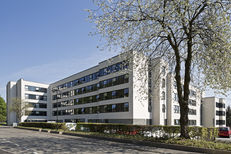Taking carbon to task at Stirling: The University of Stirling’s combined heat and power plant and residences development project
This ground breaking project contributed a 2,000t reduction of carbon emissions since 2014/5 and resulted in our new student residences receiving a BREEAM Excellent rating.
An innovative strategy saw the efficiencies offered by the installation of a Combined Heat and Power Plant (CHP) maximised through their integration into the design and development of new student residences. The collaboration between the two design teams created two mutually beneficial projects in which the residencies were sympathetic to the philosophy of the CHP and benefitted from the waste heat produced by the latter, allowing the CHP to function at maximum efficiency.
Sustainability was integrated throughout the project, ensuring that 99.5% of the waste produced was recycled or re-used. The CHP is currently providing 70% of campus electricity and 61% of campus heating and is supporting Stirling to reach our aspiration to cut carbon emissions from student accommodation by 15%.
Top 3 learnings
1 Communication and collaboration between different teams is key for high impact sustainability projects
2 Sustainable development should be seen as an opportunity for solutions and innovation, not as a restrictive burden
3 For a project to be truly sustainable, it requires strategic thinking and a holistic understanding of the campus.
CO2t Savings: 40,857 tCO2
Actual/Estimated: Estimated
No. of yrs: 15










 Except where otherwise stated, content on this site is
licensed under a Creative Commons Attribution 3.0 License.
Except where otherwise stated, content on this site is
licensed under a Creative Commons Attribution 3.0 License.
